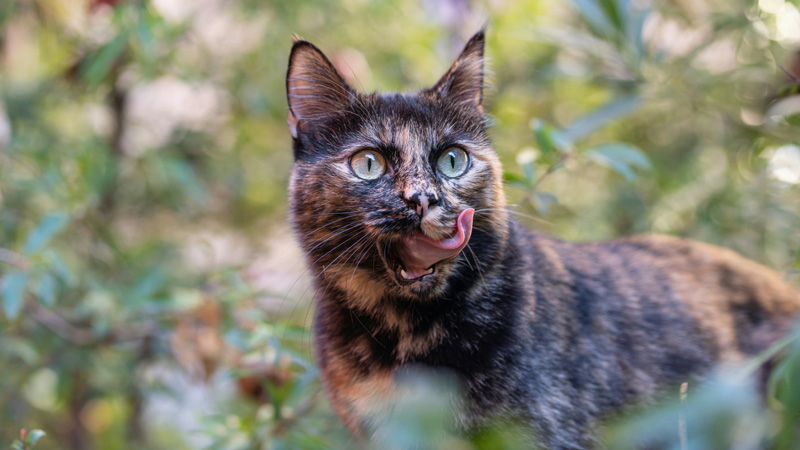The Genetic Makeup of Tabby Cats: Stripes, Spots, and the DNA

Photo by Gabriella Clare Marino on Unsplash
Tabby cats, characterized by their unique coat patterns, are among the most popular feline companions worldwide. The intricate markings on their coats are a result of specific gene expressions that influence pigmentation and fur patterns. The genetics of tabby cats are fascinating, and understanding them is crucial to unlocking the mysteries behind their coat patterns.
This article delves into the genetic makeup of tabby cats, exploring the inheritance of coat patterns, the factors influencing gene expression, and the various types of tabby patterns observed.
Evolutionary Origins of Tabby Patterns
To truly appreciate the genetic makeup of tabby cats, it's essential to explore their evolutionary origins. The ancestral wildcat species that gave rise to domestic cats exhibited a range of coat patterns, providing the foundation for the diversity seen in today's domestic feline population.
Natural selection played a crucial role in shaping these coat patterns over generations. Cats with camouflage-friendly coat patterns were better equipped to survive in their natural habitats, whether in grassy plains, forests, or rocky landscapes. As domestication took hold, the intermingling of cat populations from different regions further enriched the genetic pool, contributing to the array of tabby patterns we observe today.
The Agouti Gene and Tabby Coat Patterns
The inheritance of coat patterns in tabby cats is primarily controlled by the agouti gene, which influences the distribution of pigment within individual hairs. Several variations of this gene are responsible for producing the different tabby coat patterns seen in cats. These gene variants determine the intensity and arrangement of stripes and spots, creating the diverse coat patterns observed in tabbies.
Color Genes and Tabby Variations
In addition to the agouti gene, other genes contribute to the color variations observed in tabby cats. The combination of these genes determines whether a cat is orange, black, gray, or any other color. One of the most well-known color genes is the orange (O) gene, responsible for the production of orange pigment (pheomelanin). The presence or absence of this gene influences the cat's base color, with orange cats having the O gene while non-orange cats lack it.
Interestingly, the agouti gene interacts with the orange gene to produce the distinctive orange and black tabby patterns. Orange tabby cats often exhibit mottled or blended patterns, with the agouti gene influencing the distribution of both colors on the fur.
Genetic Variation Among Tabby Cats
The genetic diversity among tabby cats is vast, even within a single litter. This diversity arises from the combination of genes inherited from both parents, creating a unique genetic profile for each cat. While some genes control coat patterns, others influence coat length, eye color, and other physical traits.
The role of polygenic inheritance, where multiple genes contribute to a single trait, further adds complexity to the genetic makeup of tabby cats. This intricate interplay of genes results in a spectrum of tabby patterns, each cat possessing a distinct combination of genetic elements inherited from its ancestors.
Factors Influencing Gene Expression in Tabby Cats
The expression of the agouti gene variants is influenced by various environmental and genetic factors.
Temperature:
Temperature-sensitive genes affect the expression of coat patterns in tabby cats. These genes cause the appearance of faded or less intense tabby patterns in cooler parts of the body due to the regulation of fur growth and pigmentation.
Hormones:
Hormonal changes, particularly during pregnancy, can influence the expression of the agouti gene variants, resulting in changes in coat patterns.
Nutrition:
Nutrient deficiencies can also affect the expression of coat patterns in tabby cats, causing poor fur growth and discoloration.
Common Types of Tabby Patterns
Tabby cats exhibit a wide array of coat patterns, each unique in its own right. Here are some of the most common types of tabby patterns seen in cats:
Classic Tabby:
The classic tabby pattern is characterized by bold and distinct stripes on the cat's coat. The markings are evenly spaced apart, creating an almost "bull's eye" appearance.
Mackerel Tabby:
The mackerel tabby pattern is characterized by narrow, vertical stripes resembling fishbones. This pattern is the most common tabby pattern observed in cats.
Spotted Tabby:
The spotted tabby pattern consists of oval or circular spots on the cat's coat instead of stripes. This pattern often exhibits a marbled or splotched appearance.
Ticked Tabby:
The ticked tabby pattern appears as a series of agouti hairs with banding, resembling a mottled appearance.
Conclusion
While the genetic makeup of tabby cats provides a scientific lens through which we can understand their coat patterns, it is essential to remember that the true value of these feline companions extends beyond aesthetics. The playful antics, affectionate purrs, and unique personalities of tabby cats make them cherished members of countless households.
Whether your tabby cat sports bold stripes, delicate spots, or a combination of patterns, its genetic heritage contributes to the mosaic of diversity that defines the feline world. As we marvel at the beauty of tabby cats, let us also celebrate the rich genetic tapestry that has woven together these captivating creatures, making them an integral part of our lives and homes.
You May Also Like
 Black and White CatsThe 10 Cutest "Black & White" Cat Breeds
Black and White CatsThe 10 Cutest "Black & White" Cat Breeds With Green EyesThe 10 Cat Breeds With The Coolest Green Eyes
With Green EyesThe 10 Cat Breeds With The Coolest Green Eyes Blue-Gray Cats10 Blue-Gray Cat Breeds That Are Unique & Lovely
Blue-Gray Cats10 Blue-Gray Cat Breeds That Are Unique & Lovely Breed ReviewsWhat is a Tuxedo Cat? And 7 Common Breeds
Breed ReviewsWhat is a Tuxedo Cat? And 7 Common Breeds Breed ComparisonWhy is British Shorthair More Popular than American Shorthair?
Breed ComparisonWhy is British Shorthair More Popular than American Shorthair? Breed ComparisonMaine Coon vs. Normal Cat: What is the Difference?
Breed ComparisonMaine Coon vs. Normal Cat: What is the Difference?